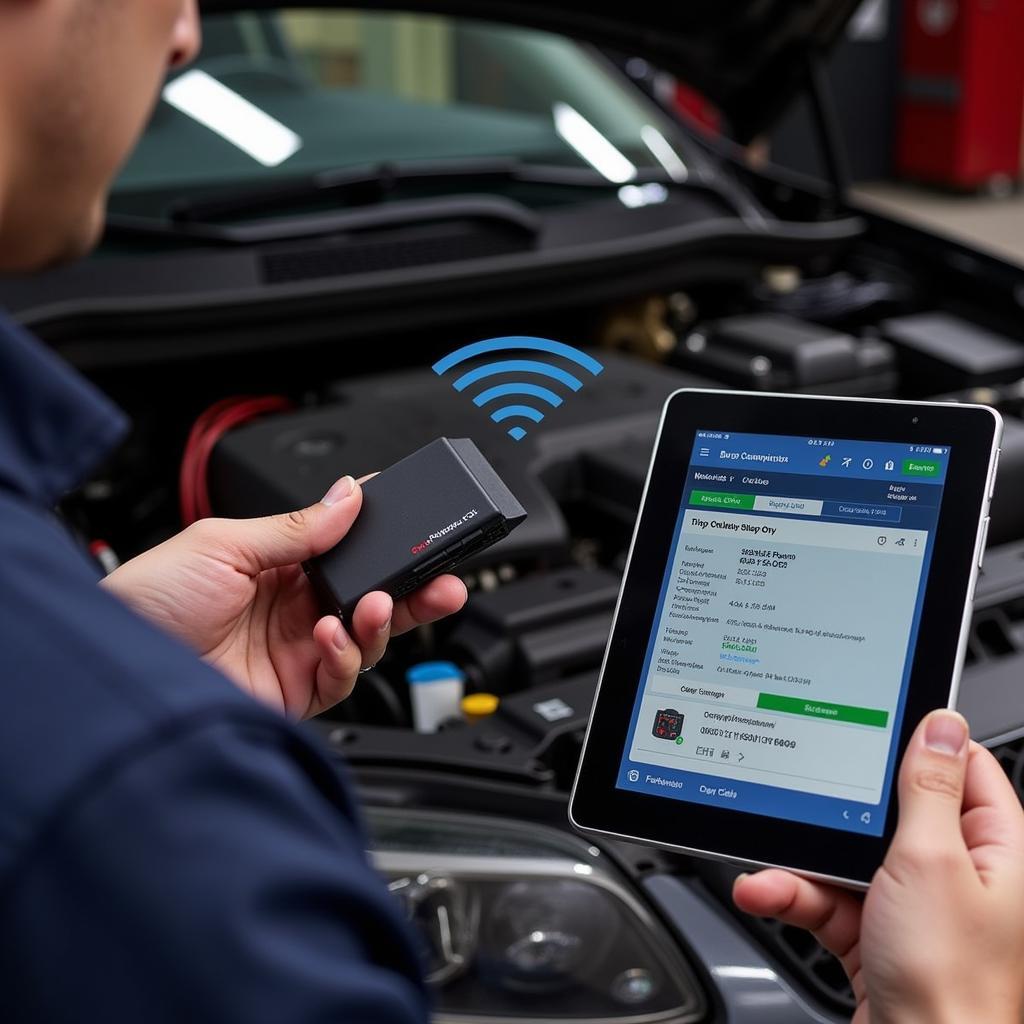A car diagnostic device is an essential tool for anyone who owns or works on cars. It’s a window into your vehicle’s electronic systems, allowing you to pinpoint issues and often avoid costly repairs. In today’s increasingly complex vehicles, understanding how these devices work and choosing the right one can save you time, money, and frustration. Let’s delve into the world of car diagnostic devices and uncover their potential.
After the check engine light comes on, many drivers dread the trip to the mechanic, unsure of what expensive repairs might be needed. A car diagnostic device can empower you to understand what’s happening under the hood. From identifying a simple loose gas cap to diagnosing more serious engine problems, these devices provide valuable insights. They’re useful for DIYers looking to tackle minor repairs and professionals seeking efficient diagnostic solutions. There is more information on car diagnostic device plugs here: car diagnostic device plug.
Types of Car Diagnostic Devices
There are several types of car diagnostic devices available, ranging from simple code readers to advanced professional-grade scanners.
OBD-II Code Readers
These basic devices read and display diagnostic trouble codes (DTCs) stored in your vehicle’s onboard computer. They are relatively inexpensive and can help you identify the cause of a check engine light. However, they typically only provide the code and not detailed information about the problem.
Handheld Scan Tools
These portable devices offer more features than basic code readers. They can read and clear codes, display live data from various sensors, and perform some basic diagnostic tests. They’re a good option for DIY enthusiasts and small repair shops. Finding the right car diagnostic device for your needs and budget is crucial. For more information about pricing, check out our page on car diagnostic device price.
Professional-Grade Scan Tools
These are high-end devices used by professional mechanics and technicians. They provide comprehensive diagnostic capabilities, including bi-directional control of various vehicle systems, advanced coding and programming functions, and access to manufacturer-specific data. These powerful tools are essential for diagnosing complex issues and performing advanced repairs. You can learn more about specific devices like the x431pro by visiting x431pro car diagnostic.
Smartphone/Tablet-Based Scan Tools
These tools utilize a smartphone or tablet app combined with a Bluetooth or Wi-Fi adapter that plugs into the vehicle’s OBD-II port. They offer a range of features similar to handheld scan tools and often provide access to a vast online database of diagnostic information. Consider exploring our guide to the best android app for car diagnostic.
 Mechanic using a Tablet-Based Diagnostic Scanner
Mechanic using a Tablet-Based Diagnostic Scanner
How to Use a Car Diagnostic Device
Using most car diagnostic devices is relatively straightforward. Locate the OBD-II port (usually under the dashboard), plug in the device, and turn the ignition on. The device will then communicate with the vehicle’s computer and retrieve any stored diagnostic trouble codes.
Benefits of Using a Car Diagnostic Device
- Early Problem Detection: Identify potential problems before they become major and costly repairs.
- Save Money on Repairs: Avoid unnecessary trips to the mechanic for minor issues you can diagnose and fix yourself.
- Improved Vehicle Performance: Monitor various sensor data to optimize engine performance and fuel efficiency.
- Greater Peace of Mind: Knowing what’s happening with your car gives you confidence on the road.
“Regularly using a diagnostic device can help prevent small problems from escalating into major headaches,” says automotive expert John Smith, ASE Certified Master Technician.
Choosing the Right Car Diagnostic Device
Consider your level of automotive knowledge, your budget, and the features you need when selecting a car diagnostic device. A simple code reader may be sufficient for basic diagnostics, while professional mechanics require advanced scan tools. For specific pricing information, especially in Johannesburg, visit our page on car key diagnostic device price in jhb.
Conclusion
A car diagnostic device is an invaluable tool for car owners and professionals alike. These devices empower users to understand their vehicles better, diagnose problems quickly, and potentially save money on repairs. Choosing the right car diagnostic device is key to unlocking its full potential.
FAQ
- What is an OBD-II port?
- Can I use a car diagnostic device on any car?
- How often should I use a car diagnostic device?
- What do the trouble codes mean?
- Can I clear the trouble codes myself?
- What if the check engine light comes back on after clearing the codes?
- Where can I find more information about car diagnostics?
Common Car Diagnostic Device Scenarios
- Check Engine Light: Diagnosing the cause of the check engine light is the most common use for these devices.
- Performance Issues: Identify sensor readings that may be causing performance problems like rough idling or poor fuel economy.
- Maintenance: Monitor system performance and predict potential maintenance needs.
Further Exploration
Explore other articles on our website related to specific car diagnostic devices, troubleshooting tips, and automotive repair advice.
Need assistance? Contact us via WhatsApp: +1(641)206-8880, or Email: [email protected]. Our customer support team is available 24/7.


